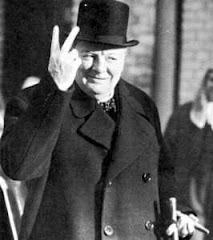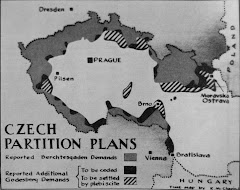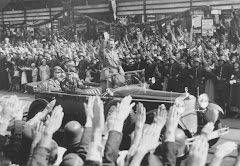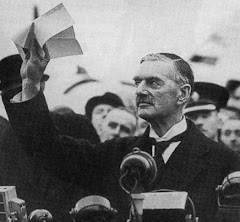Friday, December 6, 2013
Posting #10- Europe in Ruins
This is a picture of Gutte (goodness) looking down upon the city of Dresden (a centre of culture and art, considered a 'Florence on the Elbe') after the area bombing from the Allies which killed as many as 25,000 in one day.
One of the most obvious consequences of the Second World War was that Europe lay in Ruins. The material damage caused by the war was immense. Parts of the Soviet Union had been fought over four times. Warsaw was about three-quarters destroyed, and most of its people killed or dispersed. Germany had been heavily bombed and then fought over; Berlin was a scene of utter devastation. Casualties across the continent had been enormous; even greater than those which had been thought unbearable in the Great War of 1914-1918. War- related deaths in Germany were estimated at 6, 500,000, with another 374,000 in Austria, which was part of Germany for the whole of the war. Among Germany’s allies, Romania suffered some 500,000 dead and Hungary 430,000 - a high proportion of their populations. Among the victors, a commonly used figure for Soviet war dead is 20,000,000, though other estimates go as high as 25,000,000-27,000,000. Polish losses have been put at 4, 123,000, but were almost certainly higher. French losses were approximately 600,000, and those of the United Kingdom 350,000. The war deaths for the whole continent may be computed at a grievous total of something in and around 36,000,000.
At the end of the war Europe was in a state of economic dislocation and decay. Industrial production across most of the continent was low, and in some places non-existent. Transport was often at a standstill. Agricultural production could not feed the populations- food rations were low, and the northern Netherlands suffered severe famine in the winter of 1944-45. The end of the war brought a movement of peoples such as had not been seen in European history for fifteen hundred years. Between 10 and 12 million Germans (perhaps more) either fled or were driven from territories where they had lived for generations, so that east of the Oder-Neisse Line (West Poland/East Germany) and in the reconstituted Czechoslovakia only tiny German populations remained. Refugees, survivors of the death camps, slave labourers from the German war economy, and released prisoners of war wandered across lands which were sometimes almost empty of settled populations.
In the centre of this ruined continent the soldiers of the United States and the Soviet Union met. The fate of Europe was to be in their hands for a longer time than anyone could then foresee. Meanwhile, the vacuum left by the defeat and destruction of Germany had to be filled, and much would depend on how this was done. Before we move on to the long-term consequences of the war it is necessary to discuss the origins of the war, who was responsible and why things happened the way that they did. There have been revisionist and orthodox views on this subject published. Below are the major viewpoints from A.J.P Taylor’s classic book entitled The Origins of the Second World War.
His book was published in 1961, was immediately dubbed controversial, he was immediately considered a dissenter as his viewpoints of the war and Hitler seemed unbelievable. He claimed that Hitler was not an evil monster who moulded events to fit his master plan, but was a man of ‘improvisation’, ‘opportunism’ and ‘the spur of the moment bright idea’- an ordinary German statesman whose foreign policy differed little from that of earlier German governments. Taylor put forward and equally controversial view of appeasement, which he saw as being a logical and realistic assessment of the failings of the past, and as being a genuine attempt to solve them. What brought war was not appeasement, but the mistakes that Chamberlain made when he decided to abandon the policy. In Taylor’s view, war broke out not because of Hitler’s design, but because of Chamberlain’s blunders. Hitler’s foreign policy succeeded for a while, because of his ability to seize opportunities and profit from the mistakes of his opponents. These controversial views set the debate on the origins of the Second World War alight, and opened the way to a broader and less emotionally charged debate.
Research and find what percentage of the populations were killed during the second world war. Using the numbers that were given to you in the first paragraph, find population numbers pre-1939 and compile percentages. i.e war related deaths/population number pre-1939 x 100= %. Which two countries suffered the most losses as a proportion relative to their populations? Why would the estimates initially given regarding war related deaths in the Soviet Union and Poland be inaccurate as they were almost certainly higher? Why do you think that 10-12 million ethnic Germans would be in many cases forced to leave their homes in eastern Europe to forge a new life in a destroyed country such as Germany? Why were A.J.P Taylor's views considered controversial? Do you agree with him, why? Would the viewpoint outlined in his famous book be considered orthodox (traditional viewpoint) or revisionist (breaking away from mainstream/traditional) viewpoints? Support your answer. Why do you think Taylor labels Hitler as an ordinary/traditional German statesman? Do you agree?
This posting is now open and will close at 11pm on December 20th. Any student who is not included in posting #1 or 2 will be doing this posting.
There has been lack of participation on this posting, as a result the deadline will be extended until December 31st.
Subscribe to:
Post Comments (Atom)



















2 comments:
Country – War related deaths / Pop. Pre 1939 = Death percentage
Germany - 6,500,000 / 69,850,000 = 9.3%
United Kingdom - 350,000 / 47,760,000 = 0.7%
Austria - 374,000 / 6,650,000 = 5.6%
Romania – 500,000 / 19,934,000 = 2.5%
Soviet Union – 20,000,000-27,000,000 / 168,524,000 = 11.8% - 16.0%
France – 600,000 / 41,700,000 = 1.4%
Polish – 4,123,000 / 34,849,000 = 11.8%
Hungary – 430,000 / 9,129,000 = 4.7%
Soviet & Polish deaths were certainly higher than originally estimated due to the fact that there was a surplus of attacks, not only on the soldiers, but on the general civilian population, there was also an almost incalculable amount of Jewish civilians put into concentration camps all over the country. Another reason as to why this is most certainly a higher death rate is due to the scorched earth policy the Russians used during warfare, we don’t know how many people were forgotten among the factories and houses.
The Soviet & Polish had the most deaths because they were not prepared for war to happen on the land 4 times or the outcomes that went along with it. They assume the number of deaths were higher because they must have gotten the number from amount of bodies found or families that didn't report their soldier arrived back home. Many bodies could have been burned, drowned, or hidden. Germans were forced to leave Europe because of the lack of food & economy because of the war. AJP Taylors views were considered controversial because most people thought what Hilter was doing was wrong, but he almost agreed with him saying he was just a little different then what others were doing. I disagree with him because even if he had many people mesmerized by his speeches, he was extremely racist & had no reason to kill so many people like he did. Taylor is considered a revisionist because most people would agree Hilter wasn't doing the right thing. He thought Hilter was just an ordinary statesman because he didn't see all the people who's lives were destroyed under Hitlers rule.
Post a Comment